
Global Knowledge Network On Voter Education - learning from each other
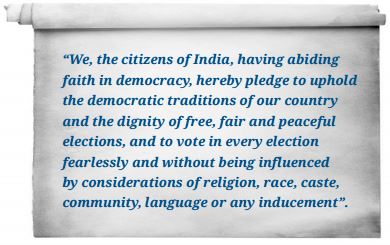
Voters’ Participation in the democratic and electoral processes is integral to the successful running of any democracy and the very basis of wholesome democratic elections. Thus, it becomes an integral part of election management. In India, the constitutional mandate of the ECI for ‘superintendence, direction and control’ of elections contain the built in high responsibility to have every eligible Indian on the electoral roll and get everyone on the electoral roll to voluntarily vote. The election management processes have gone from strength to strength over the decades and have responded ably to emerging challenges.
India’s Constitution laid out the aspiration that every adult Indian regardless of gender, formal education, socio economic status or location would have a right to vote and every vote would count the same. To many it looked an audacious aspiration, even impracticable in a country of this size, with limited physical infrastructure, with low levels of literacy and wide diversity.
Election Commission of India(ECI) successfully converted this aspiration into a reality. This was undoubtedly a gigantic task, right from enumerating voters to locating polling booths at easily accessible places and ensuring secrecy and security of the ballot paper. The sheer number of voters and the logistical challenges on account of distances and accessibility were truly huge.
ECI has also been quick in keeping itself abreast of technological changes and in introducing improvements in the electoral process. Photo Electoral rolls are computerized, voters have voter identity cards, proceedings in sensitive polling booths are video-graphed, polling at several booths is webcast, political parties have free time on national television and national radio, ballot papers and ballot boxes have been replaced by electronic voting machines, Voter verifiable paper audit trail (VVPAT) has been introduced to verify that votes cast by the voter goes to the intended candidate. Results now get declared in one day. Each of these changes was, in some sense, a break-through. These improvements have contributed not only to the speedy conduct of elections but also to enhancing the transparency and credibility of the whole electoral process.
Dimensions and challenges of Voter participation
Lok Sabha 2014 elections involved up to 834 million electors1, using over one million Electronic Voting Machines (EVMs) and covered over 919,452 polling stations. Like many democracies across the world that are experiencing declining voter turnout and increasing apathy to vote amongst specific groups of people, India faced the same problem. In the 2009 parliamnetary elections (Lok Sabha), 417 million voters turned up to vote. 717 million were registered as electors and 300 million people did not turn out to vote. It was observed that women, youth and urban electors had lower participation in these elections.
Realising the gravity of this participation deficit in the electoral process, ECI chose the theme for the Diamond Jubilee Year of the Election Commission in 2010 as “Greater Participation for a Stronger Democracy”. ECI underlined that it needed to tread the last mile, where issues like healthy and complete electoral rolls, urban apathy, women’s participation deficit and youth indifference to the electoral process were to be tackled. Participation based on voluntary inclination/ motivation of the individual voters and persuasion by election management machinery needed to be encouraged. The Commission thus decided to bring Voter education to the center table of election management and allocated it necessary priority and resources.
The Foundation of Voter Education
To meet the challenge of eligible and yet unregistered citizens and not so high voter turnout, ECI started reaching out to citizens to understand what was stopping them from registering in the electoral rolls and voting. Certain amounts of Information, Education and Communication (IEC) activities were taken up in 2009 to benefit the voters. This was subsequently revamped in 2010 as a national programme titled Systematic Voters’ Education and Electoral Participation (SVEEP).
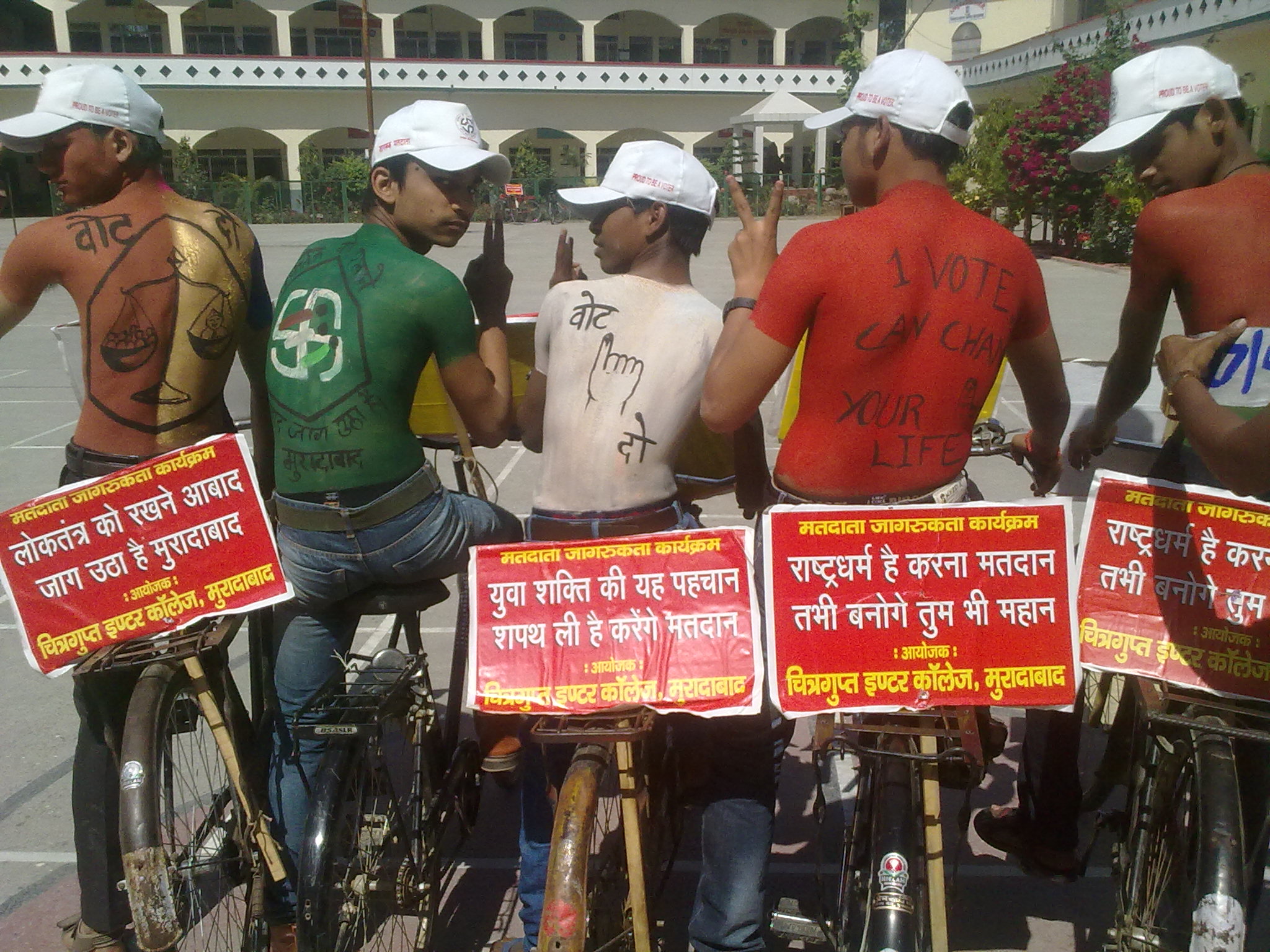
Since its inception, SVEEP has grown into a strategic, scientific, systematic and synergistic programme with well chalked out framework and robust structural set-up at national, provincial and grass root level for its effective implementation.
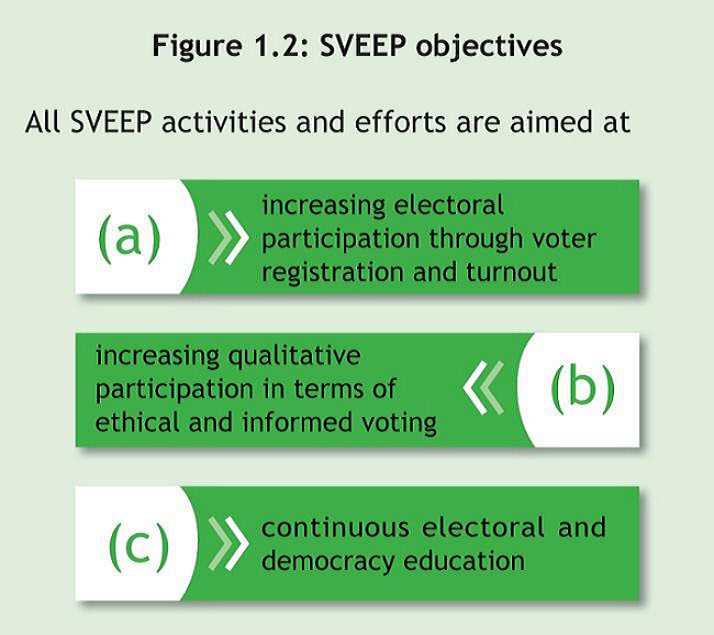
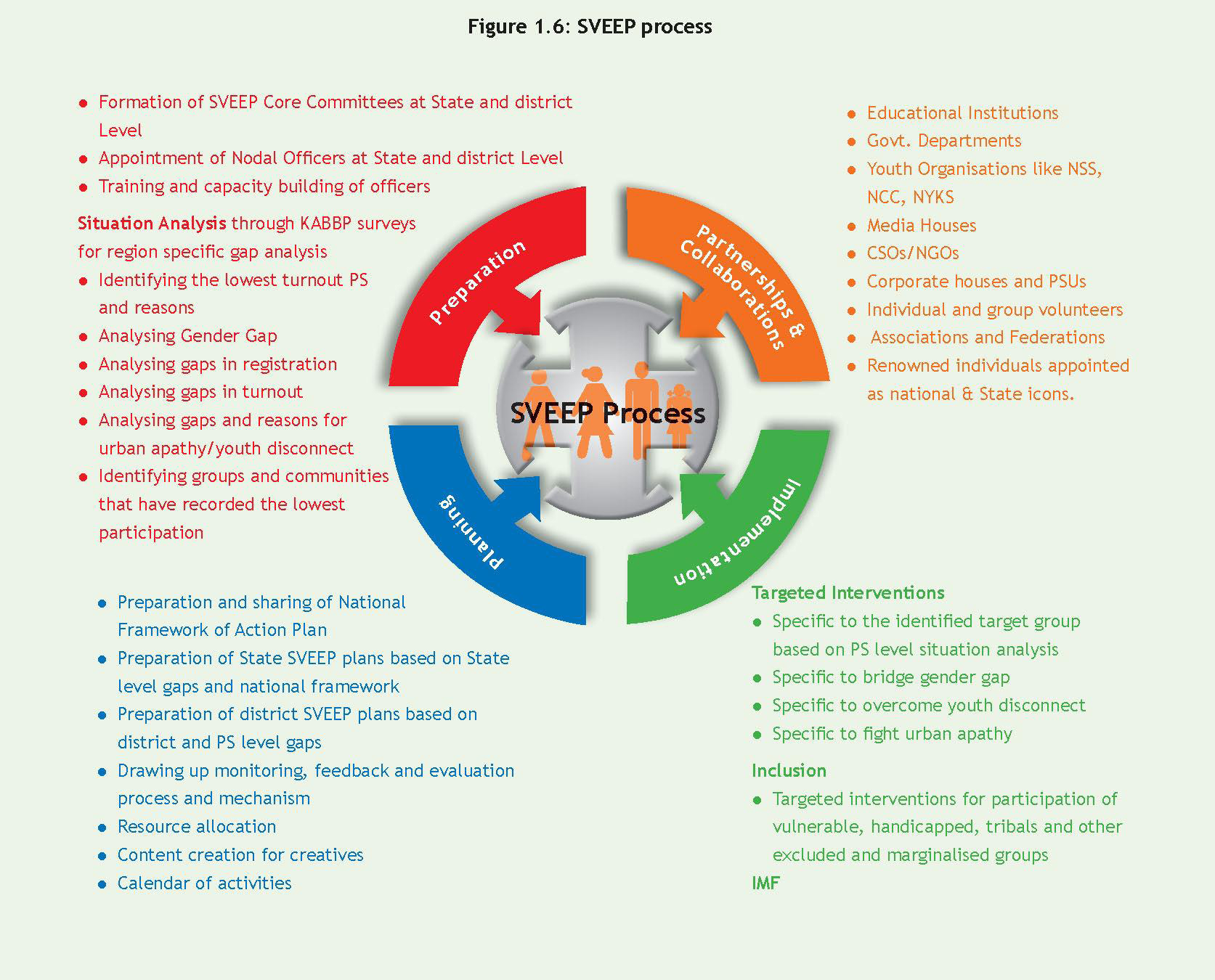 At national level, SVEEP Division at ECI formulates policies, lays down the framework, plans interventions and monitors implementation besides carrying out continuous discourse with voting publics, civil society groups and media from a national perspective. At provincial level, in each of the State Chief Electoral Office, an officer is assigned the charge of the SVEEP programme in the state. Core groups comprising representatives from educational institutions, youth organizations, women’s organisations and Civil Society Groups guide the State election machinery in evolving and executing a comprehensive SVEEP plan. At District level the institution of District Collector- the administrative head of the district traditionally plays the key role in election management and spearheads the implementation of the SVEEP programme. A district SVEEP committee is constituted at the District level headed generally by the Chief Executive officer or Chief Development Officer to supervise the implementation of the programme in the district.
At national level, SVEEP Division at ECI formulates policies, lays down the framework, plans interventions and monitors implementation besides carrying out continuous discourse with voting publics, civil society groups and media from a national perspective. At provincial level, in each of the State Chief Electoral Office, an officer is assigned the charge of the SVEEP programme in the state. Core groups comprising representatives from educational institutions, youth organizations, women’s organisations and Civil Society Groups guide the State election machinery in evolving and executing a comprehensive SVEEP plan. At District level the institution of District Collector- the administrative head of the district traditionally plays the key role in election management and spearheads the implementation of the SVEEP programme. A district SVEEP committee is constituted at the District level headed generally by the Chief Executive officer or Chief Development Officer to supervise the implementation of the programme in the district.
Since 2006, ECI has introduced the institution of Booth Level Officers, popularly known as BLOs, who generally cover one or two Polling Stations and are responsible for maintaining the Electoral Roll in good health. They now constitute primary block SVEEP related connectivity with citizens.
SVEEP- Systematic Voters’ Education and Electoral Participation
The overarching framework of the strategy for voter registration and participation named as IMF (Information, Motivation and Facilitation) comprises of a plethora of systematic interventions to involve the people in the electoral process.
Situation analysis
The systematic assessment of current and previous electoral data is carried out to guide the interventions. In addition to comparative studies of statistical and numeric data, a simultaneous evidence based analysis of socio-cultural and economic factors is done in order to have a clear understanding of reasons for non-participation. The assessment is done based on population data, elector-population ratio, gender ratio on roll as against census figures, elector’s photo identity card (EPIC) coverage, age cohort, etc. Survey agencies are engaged for carrying out baseline and endline survey to find the underlying reasons for under registration, last mile problems in updation of Electoral Rolls, EPIC take off and low voter turnout and to identify the demographics of elector segments with lower electoral participation so that suitable interventions can be mounted and their impact assesses. The nomenclature of Voters’ behaviour survey has been changed to survey of knowledge, attitude and practices (KAP) of voters.
Targeted Interventions
In order to improve participation of all sections of electorate, ECI decided to bridge the gap through targeted interventions for meeting gender gap, fighting urban apathy and overcoming youth disconnect. Targeted interventions are carried for identified left out groups/communities in partnership with identified agencies/support groups for meeting registration gaps during roll revision and ahead of elections.
Partners and Collaborations
Working with partners is an important part of the strategy, as any implementation as well as planning process shall require inputs and support from various agencies and departments. The Election Commission collaborated with educational institutions and youth organizations to particularly tap the new voters in the age group of 18-19yrs, promote greater awareness amongst youth and students about electoral process and to seek their assistance in facilitating voter registration. It also collaborated with Central and State Government Departments like the departments of health, education, women and child development, Cooperatives, Welfare etc., so that these departments can extend their existing infrastructure and manpower (field functionaries) for electoral education and outreach. Collaboration with Government and private media as well as Civil Society and credible NGOs for increasing people’s awareness regarding electoral participation has also helped in creating voter awareness. Even the private media houses and Corporates are joining in and extending support to the SVEEP programme. ECI has developed separate ‘Framework of Engagement’ with CSOs, Media Houses and Corporate.
Media & Communication
A range of media are utilised for communication and reaching out to the potential voter population with a variety materials and campaigns for taking the message forward. For the widest possible availability of information easily and readily various mediums of information are employed for the purpose. Mass media like Electronic (Radio, TV, Film), Print, mid media, Social media, Inter personal communication, local and folk media and innovative collaterals are used for the purpose.
• Communication campaigns through mass media, folk media and other media vehicles besides direct people-to-people contact.
• While rural women were targeted through inter-personal communication through literacy and health workers, Social media and internet is used to reach out to the urban population and youth.
• Posters and pamphlets and folk media including street plays are widely used to reach out to rural population.
• The facility for online registration of voters is the only system in India where one can get an identity card, i.e., Elector Photo Identity Cards (EPIC) without visiting a government office. National Voter Service Portal (NVSP) provides all kind of information and services to citizens. Social media is being used at district and state level for enhancing voter awareness and increasing voter turnout increasing polling percentage. Most of the state chief electoral offices own face book pages for reaching out techno-savvy young voters.
Motivating the people
The task of enthusing and inspiring the disinterested and alienated citizens and address their apathy and skepticism to make possible their participation in the electoral process is imperative for greater electoral participation. It is crucial to associate a sense of pride with the right and duty of exercising one’s franchise. Identifying the ability of inspirational personalities to establish authentic connection with the masses, ECI associated with renowned Indians from various field enjoying national appeal and appointed them as ECI’s National Icons to motivate Voters. Similarly renowned individuals in states were appointed as State Icons.
Physical Events and Activities


A variety of physical events and activities are taken up under SVEEP for motivation and mobilisation.
• Competitions like drawing, debates, declamations, quiz in educational institutions on elections and voting
• Activities like local and folk art competitions targeting rural women
• Song writing competitions and Rock festivals in public places to interest urban youth
• Sporting events like kite flying, motor rallies, cricket tournaments, wrestling events, marathon runs
• Mass mobilisation events like rallies, human chains, and candle light vigils are utilized with good effect
• Pledge to vote by masses in educational institutions, gram Sabha, gathering and special events
• Entertainment shows converging with awareness inform of street plays, magic shows, fashion shows
• Flash mobs in malls, celebrity endorsement, online quizzes targeting urban populace
• Mock polls and dummy polling stations are effectively used to engage people
Facilitating the Voter
Greater participation of the public in elections can be guaranteed by making the process and procedures voter-friendly. The final step of the SVEEP strategy holds great importance as an informed, aware and motivated public geared up to contribute to the democratic machinery needs to be complemented with measures that make their participation easier and smoother. There could be a risk of credibility loss if after generating demand, there is a shortfall in supply.
Voter Facilitation Centres, providing voter slips ahead of polls, separate queues for women and aged, women polling officials to assist women voters, and increase in number of polling stations so that every voter can reach one within 2 kilometers are some of the popular facilitation measures.
• Online registration made available on ECI website and also CEO’s website
• Name search facility on electoral roll on the CEO’s website and also ECI website
• SMS based service for searching name and polling booth
• Information on election laws and rules and the Guidelines and also details regarding the Election Officials including the ROs, AROs, BLOs available on CEO website
• Voters’ Facilitation Centres are citizen friendly centres to facilitate citizens on electoral roll issues and EPIC cards”. Electoral roll issues of citizens are additions, deletions, modifications and transpositions of their names to the roll. VFC is a one stop service for citizens.
• Registration Forms made available at prominent places including Banks and Post Offices, Colleges and Universities, and also in High Schools for newly eligible electors.
• Special registration camps in weekly markets, during festivals and through mobile vans ahead of elections.
• Poll hours extended to 11 hours in most regions to facilitate voters in the national elections 2014.
• Assured Minimum Facilities (AMF) - ramps, toilets, electricity, sheds and drinking water at every Polling Station.
• Model Polling Stations (MPS) established at various locations to provide additional facilities to voters to make voting a pleasant experience.
• Separate queues for men and women at the polling stations to facilitate women voters. Also in infirm, old and physically challenged voters are given priority in voting at the booth.
• Volunteers at Polling Booths to assist senior citizens and infirm voters, wheelchair for persons with disability.
• Braille facility on EVM and tactile signages for visually challenged voters.At each polling station, an alphabetical list of electors is also displayed prominently which makes the task of locating the elector’s serial number in the polling station much easier.
• A basket of alternate photo identity documents that can be used for voting are announced ahead of poll day. Wide publicity is given about these alternate documents to facilitate people to vote in absence of EPIC.
• Voter Guide and Photo Voter Slips for every voter delivered at residence few days ahead of poll day. These carry the name and details of the polling booth and serve as identification on the poll day.
• Voters’ Facilitation Centres to assist voters and provide requisite information about voting and services like display of Voter lists, issue of duplicate EPIC etc.
• Search facility for name on voter list on national and CEO websites and through SMS.
• Voters’ Helplines in districts to facilitate the voters in getting right information.
• Polling day reminders through SMS and also on Radio and Television and through Public address systems.
Monitoring & Evaluation
To assess the efficacy of implementations and derive learnings for improvement, mid period review and constant monitoring of SVEEP programmes are conducted. Regular Video Conferences are organised by CEO with all DEOs for review of implementation. The programme is reviewed at the national level by the Director General who keeps the Commission briefed. Statistical studies, innovations and case studies along with the creative material produced are compiled at DEO and CEO level and shared with the Commission for replication and scaling up.

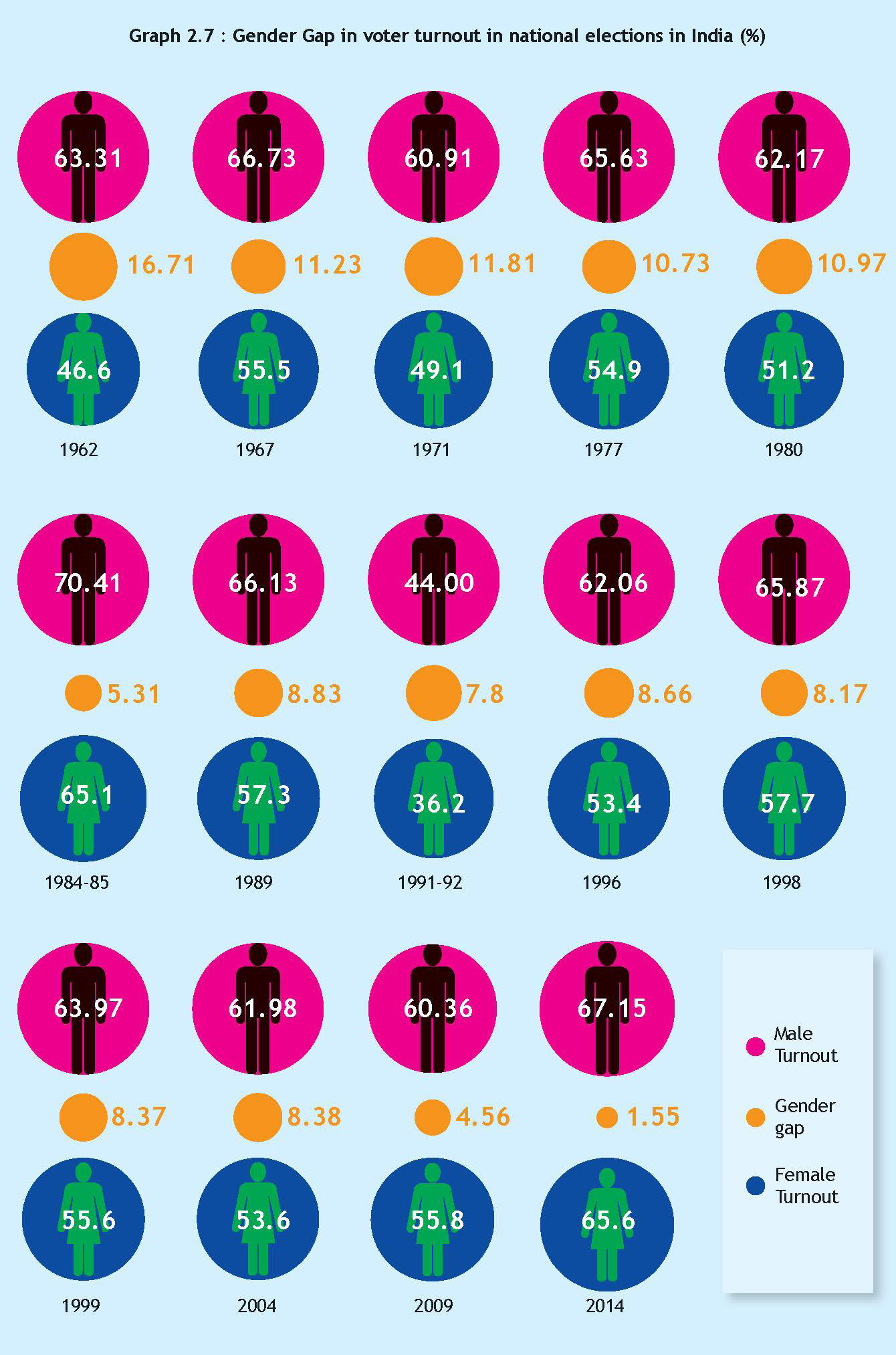
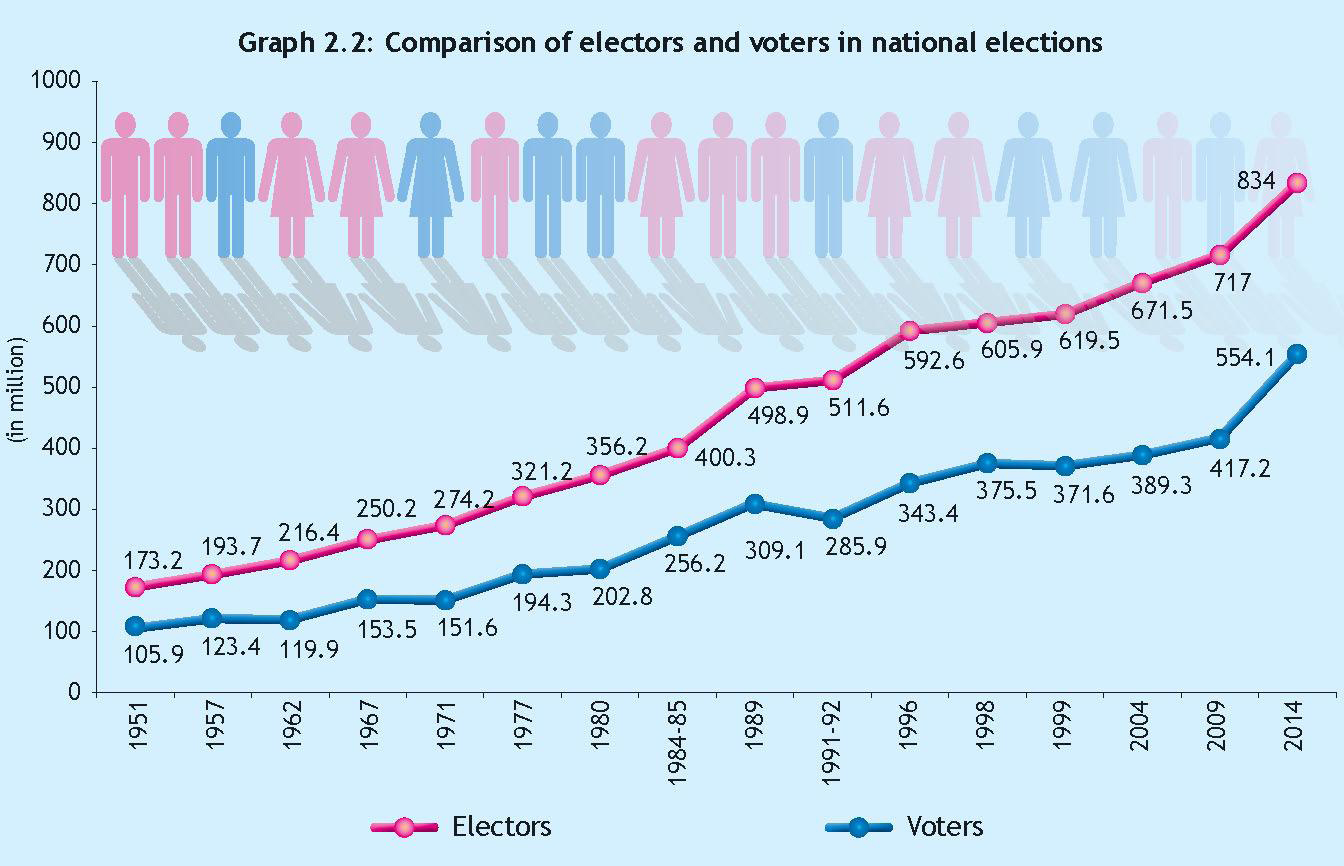
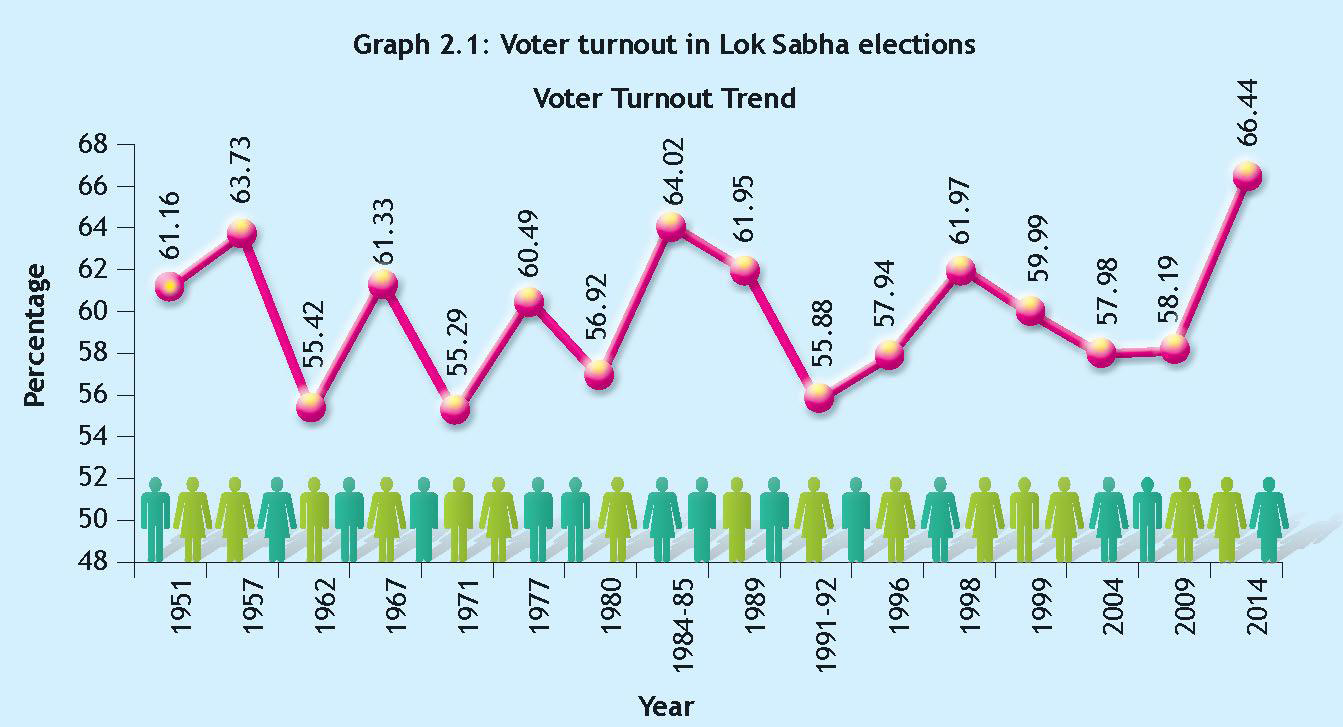
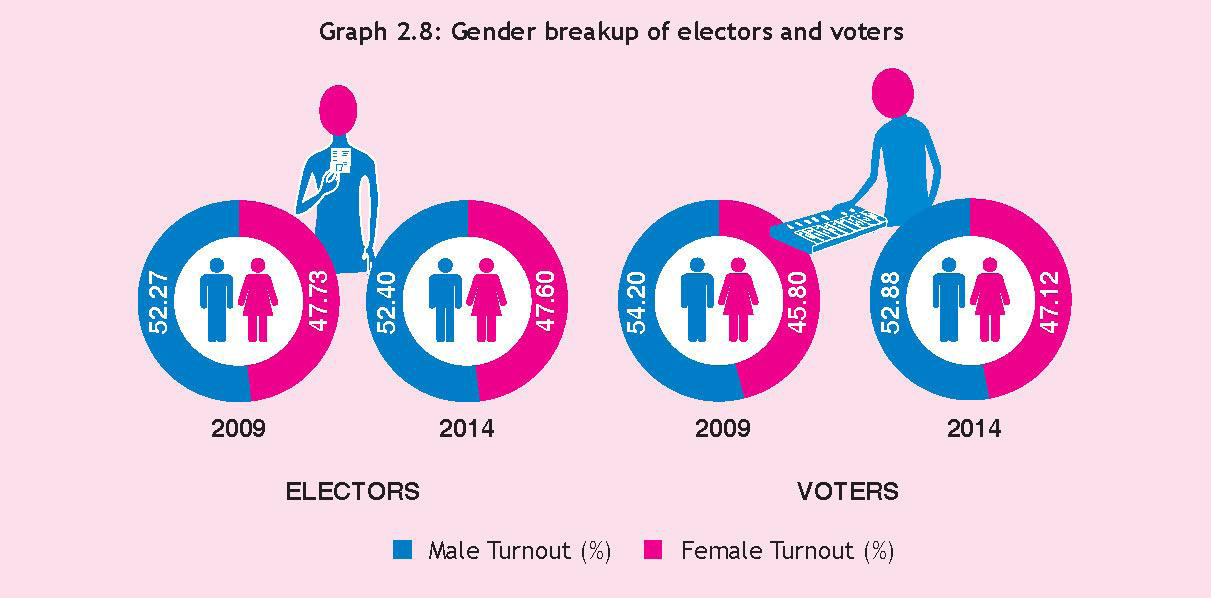
Padma Angmo
Director,
Election Commissionof India.